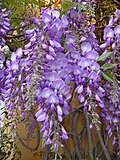Invasive plants
The following are some of invasive plant species established in West Virginia:
| Picture | Scientific Name | Common Name |
|---|---|---|
 | Ajuga reptans | bugle |
 | Akebia quinata | chocolate vine |
 | Alliaria petiolata | garlic mustard |
 | Arctium minus | lesser burdock |
 | Bidens aristosa | bearded beggarticks |
 | Bromus tectorum | drooping brome |
 | Buddleja davidii | summer lilac |
 | Carduus acanthoides | spiny plumeless thistle |
 | Carduus crispus | curly plumeless thistle |
 | Carduus nutans | musk thistle |
 | Centaurea jacea | brown knapweed |
 | Cirsium arvense | Canada thistle |
 | Cirsium vulgare | spear thistle |
 | Convolvulus arvensis | field bindweed |
 | Dioscorea polystachya | Chinese yam |
 | Dipsacus fullonum | wild teasel |
 | Elaeagnus umbellata | Japanese silverberry |
 | Euphorbia cyparissias | cypress spurge |
 | Hedera helix | common ivy |
 | Hesperis matronalis | dame's rocket |
 | Inula helenium | horse-heal |
 | Isatis tinctoria | woad |
 | Lespedeza cuneata | Chinese bushclover |
 | Ligustrum vulgare | common privet |
 | Lonicera japonica | Japanese honeysuckle |
 | Lonicera maackii | Amur honeysuckle |
 | Lotus corniculatus | common bird's-foot trefoil |
 | Miscanthus sinensis | maiden silvergrass |
 | Myriophyllum spicatum | Eurasian watermilfoil |
 | Phragmites | |
 | Pyrus calleryana | callery pear |
 | Rhamnus cathartica | buckthorn |
 | Rhodotypos scandens | jetbead |
 | Rubus laciniatus | cutleaf evergreen blackberry |
 | Salix × fragilis | crack willow |
 | Securigera varia | crownvetch |
 | Solanum dulcamara | bittersweet |
 | Sorbus aucuparia | rowan |
 | Stellaria media | chickweed |
 | Tanacetum vulgare | common tansy |
 | Tussilago | coltsfoot |
 | Verbascum thapsus | great mullein |
 | Vinca minor | lesser periwinkle |
 | Wisteria sinensis | Chinese wisteria |